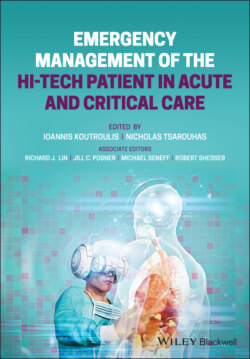Читать книгу Emergency Management of the Hi-Tech Patient in Acute and Critical Care - Группа авторов - Страница 83
Infection
ОглавлениеCatheter‐related infections are among the most common reasons for ED visits among patients with indwelling venous‐access devices. Because CVCs provide direct access to the central venous circulation, the risk of sepsis in patients with infected lines is a significant concern. This risk is exacerbated by the fact that the patients in whom these lines tend to be placed (e.g. immunocompromised oncology patients, gastrointestinal patients with diminished bowel‐wall integrity) are by the nature of their underlying illness more likely to succumb to invasive infections. Therefore, any patient presenting to the ED with fever and an indwelling CVC should be considered septic until proven otherwise. Standard care for febrile patients with indwelling CVCs includes culturing each lumen of the catheter as well as a peripheral site, and initiation of broad‐spectrum antibiotics (usually vancomycin and a third‐ or fourth‐generation cephalosporin – though antimicrobial recommendations vary widely by institution and according to local resistance patterns). CVC infections can range from systemic infections (bacteremia, fungemia, and sepsis) to local infections (exit‐site or tunnel cellulitis, or “pocket infections” in the chest wall of patients with implanted ports). Practitioners should carefully examine the catheter exit site, the skin overlying an implanted port, and the entire palpable length of the subcutaneous tunnel for signs of redness, swelling, warmth, drainage, or tenderness. Streaking overlying the tunneled portion of an indwelling CVC is highly suggestive of a tunnel infection and is usually grounds for removal of the line in addition to administration of IV antibiotics. The most common organisms cultured from infected CVCs include Staphylococcus aureus, coagulase‐negative staphylococci, gram‐negative organisms such as Klebsiella pneumoniae and Escherichia coli, and fungi, especially Candida species. Catheter infections and catheter‐associated soft tissue infections are most likely to occur in the first 100 days after device insertion, and in patients who were neutropenic at the time of placement, so practitioners should take care to inquire about these risk factors when working up a patient in whom they have a concern for CVC infection. When treating a patient for presumed CVC infection, the treatment team managing the patient's primary underlying condition should be contacted to assist with the selection of antimicrobial therapy.
Table 5.2 Procedure for accessing an implanted central venous catheter.
| Identify the patient, and explain the procedure to the patient and family.Position the patient safely. Supine positioning is preferred; women and adolescent girls should have their brassiere removed on the side of the catheter.If anesthetic cream was applied to the skin overlying the port, wipe it away before cleansing with povidone‐iodine or chlorhexidine (for patients over 2 months).Perform hand hygiene and don sterile gloves. Most institutions will also require practitioners and patients to wear a mask.Place a sterile towel or drape on the patient's chest below the port to create a sterile field.Attach a 10 cc syringe of saline to extension tubing; attach the other end of the tubing to the noncoring needle. Flush the length of tubing and needle to remove air and lay it on the sterile field.Triangulate the dome of port between the thumb and fingers of nondominant hand. Aiming for the center point of these fingers, use dominant hand to insert noncoring needle perpendicular to the skin and through the septum of the port.Unclamp extension tubing and slowly infuse 2–5 cc of saline; if the line flushes easily, aspirate saline and check for blood return.If there is resistance to fluid infusion or no blood return with aspiration, do not force fluid into the reservoir. Reclamp the tubing and see section on troubleshooting an occluded CVC.If there is successful blood return with aspiration, instill the remaining saline in the syringe. Tape the needle in place at 90° to the dome of the port and apply a clear, sterile dressing. Clamp the tubing and remove the syringe.If the line is needed for blood drawing, aspirate 3–5 cc from the line prior to clamping, as in Step 10. Discard this saline‐and‐blood mixture, and attach a new, empty syringe to the extension tubing. Unclamp the tubing and withdraw the needed volume of blood. Reclamp the tubing, attach a second 10 cc syringe of saline, unclamp the tubing, and flush to clear blood from the line. Clamp the tubing after flushing and remove the syringe.If the line is needed for infusion of medications or fluids, connect primed IV tubing to the catheter hub, unclamp the catheter, and administer fluids or medications as care dictates. |
